June 1, 2021
Joan Miro
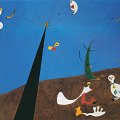 Joan Miro, a Spanish Catalan painter, internationally
acclaimed for his painting art which has been interpreted as
Surrealism, a sandbox for the subconscious mind, with strong traits
of innocence, minimalism, and the child-like character. Miro was at
the beginning of the Surrealist movement, but later he chose not to be
labeled as a Surrealist in order to be free to experiment with other
artistic movements and styles. He developed his own unique style: organic
forms and flattened picture planes drawn with sharp lines. He tried to
express himself through new materials: bark, textile, fiber, assemblages of
objects, collages, and so on. Miro has been a significant influence on late
20th-century art, in particular the American abstract expressionist
artists, such as Pollock and Rothko, with his lyrical abstractions and
color field paintings. "My characters have undergone the same process of
simplification as the colors. Now that they have been simplified, they
appear more human and more alive than if they had been represented in all
their details." - Joan Miro.
Joan Miro, a Spanish Catalan painter, internationally
acclaimed for his painting art which has been interpreted as
Surrealism, a sandbox for the subconscious mind, with strong traits
of innocence, minimalism, and the child-like character. Miro was at
the beginning of the Surrealist movement, but later he chose not to be
labeled as a Surrealist in order to be free to experiment with other
artistic movements and styles. He developed his own unique style: organic
forms and flattened picture planes drawn with sharp lines. He tried to
express himself through new materials: bark, textile, fiber, assemblages of
objects, collages, and so on. Miro has been a significant influence on late
20th-century art, in particular the American abstract expressionist
artists, such as Pollock and Rothko, with his lyrical abstractions and
color field paintings. "My characters have undergone the same process of
simplification as the colors. Now that they have been simplified, they
appear more human and more alive than if they had been represented in all
their details." - Joan Miro.
- Joan Miro Art, $35
 (150 pictures)
(150 pictures)
May 15, 2015
Amedeo Modigliani
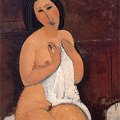 Amedeo Modigliani, an Italian painter, known for his
portraits and erotic nudes, deliberate distortion of the
figure and free use of large, flat areas of color. Despite their extreme
economy of composition and neutral backgrounds, Modigliani's portraits
convey a sharp sense of the sitter's personality, featuring a simple but
monumental use of line, and arresting arrangement of curved lines and
planes as well as a striking idealization of feminine sexuality. His art
was very individual and unique, especially later in his career. His
incisive portraits, erotically charged nudes, elegant drawings of
caryatids, and primitivistic sculpture have been admired for decades.
Modigliani's portraits and single-figure paintings are among the most
memorable and popular images of the early twentieth century. They possess
an archetypal quality that sets them apart from the art of his
contemporaries in Paris. Like the artist's nudes, they testify to an
enduring fascination with the human form and physiognomy.
Amedeo Modigliani, an Italian painter, known for his
portraits and erotic nudes, deliberate distortion of the
figure and free use of large, flat areas of color. Despite their extreme
economy of composition and neutral backgrounds, Modigliani's portraits
convey a sharp sense of the sitter's personality, featuring a simple but
monumental use of line, and arresting arrangement of curved lines and
planes as well as a striking idealization of feminine sexuality. His art
was very individual and unique, especially later in his career. His
incisive portraits, erotically charged nudes, elegant drawings of
caryatids, and primitivistic sculpture have been admired for decades.
Modigliani's portraits and single-figure paintings are among the most
memorable and popular images of the early twentieth century. They possess
an archetypal quality that sets them apart from the art of his
contemporaries in Paris. Like the artist's nudes, they testify to an
enduring fascination with the human form and physiognomy.
- Amedeo Modigliani Art, $29
 (135 pictures)
(135 pictures)
- Amedeo Modigliani. Portraits and figure paintings.
- Amedeo Modigliani. Erotica art nudes.
May 15, 2012
Paul Cezanne's artwork is most expensive at $250 million
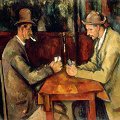 This is the painting that has cost
the Qatari royal family a record-breaking $250 million. Exact price (even
the currency of sale) is not known, with estimates from $259 million to
even $300 million. The quarter of a billion dollar price tag makes Cezanne's
The Card Players the world's most expensive artwork. The deal, in
a single stroke, sets the highest price ever paid for a work of art and
upends the modern art market. It smashes the previous record for a Jackson
Pollock.
This is the painting that has cost
the Qatari royal family a record-breaking $250 million. Exact price (even
the currency of sale) is not known, with estimates from $259 million to
even $300 million. The quarter of a billion dollar price tag makes Cezanne's
The Card Players the world's most expensive artwork. The deal, in
a single stroke, sets the highest price ever paid for a work of art and
upends the modern art market. It smashes the previous record for a Jackson
Pollock.
The Card Players is actually a series of oil paintings from Paul Cezanne, there are five total paintings, three of them are available in high resolution in the Cezanne art pack for only $25. In the comfort of your own home you have the chance to stare at the most ($250M) expensive painting for $25 only! The series is considered by critics to be a cornerstone of Cezanne's work during the early-to-mid 1890s period, as well as a prelude to his final years, when he painted some of his most acclaimed work.
February 8, 2012
2.5 GB milestone
In recent months the majority of the packs in MoodBook art collection have been updated with the highest-quality FullHD, life-like images:
-
Leonardo da Vinci Art, $25
 (80 pictures)
(80 pictures)
-
Raphael Art, $25
 (125 pictures)
(125 pictures)
-
Titian Art, $29
 (175 pictures)
(175 pictures)
-
Caravaggio Art, $25
 (100 pictures)
(100 pictures)
-
Rembrandt van Rijn Art, $25
 (160 pictures)
(160 pictures)
-
Peter Paul Rubens Art, $29
 (200 pictures)
(200 pictures)
-
Francisco de Goya Art, $25
 (115 pictures)
(115 pictures)
-
William Bouguereau Art, $25
 (175 pictures)
(175 pictures)
-
Edgar Degas Art, $25
 (170 pictures)
(170 pictures)
-
Paul Gauguin Art, $25
 (125 pictures)
(125 pictures)
-
Paul Cezanne Art, $25
 (125 pictures)
(125 pictures)
-
Edvard Munch Art, $19
 (75 pictures)
(75 pictures)
-
Henri Matisse Art, $29
 (180 pictures)
(180 pictures)
-
Paul Klee Art, $25
 (150 pictures)
(150 pictures)
The combined size for the above packages has been increased five-fold from 300 MB to around 1.5 GB. Also, the total size for MoodBook collection is now 2.5 GB (2.5 gigabytes), and keeps growing! There should be no problem downloading 100+ MB art packs using most Internet connections. If you have a license for any of the packs listed above, you can re-download your pack/packs free of charge, to enjoy better resolution and life-like details.
We recommend using FullHD IPS (In-Plane Switching) TFT LCD display monitors from LG, HP, Dell, and Philips, as well as FullHD plasma TV panels from Panasonic and Samsung. Viewing art on any of these displays could give you a mind-blowing experience. IPS panels feature unmatched color reproduction and display consistent and accurate color from all viewing angles. Other panels may only display partial true color. The discrepancy is normally more than 2 times in terms of color shift. IPS panels are twenty times better than normal panels in comparative changes in gamma shift.
February 1, 2012
MoodBook DVDs
Physical delivery has been suspended, MoodBook DVD-ROMs are out of stock. We're moving towards digital download delivery policy. Soon the MoodBook Art Deluxe package will be available as a digital download option only.
January 1, 2012
Free fine art wallpapers
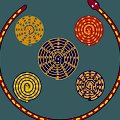 There's always something happening in
the MoodBook world! Over the past few months, MoodBook web-site has gone
through quite a few changes - some big, some small, all designed to make
the web-site that much better for our readers. For better preview, free
wallpaper images are now available on each artist's page. Free sample
wallpapers have been generated using the FullHD 1920x1080 display
resolution. MoodBook will automatically use the appropriate image
resolution for your computer display. The process of painting/image
adaptation for your desktop is transparent, fully-automatic, and
implies high-quality digital image processing. Enjoy the new look and feel
of the main wallpaper art page - there are over 100 high-resolution FullHD fine
art images now and all of them are available for free online download.
There's always something happening in
the MoodBook world! Over the past few months, MoodBook web-site has gone
through quite a few changes - some big, some small, all designed to make
the web-site that much better for our readers. For better preview, free
wallpaper images are now available on each artist's page. Free sample
wallpapers have been generated using the FullHD 1920x1080 display
resolution. MoodBook will automatically use the appropriate image
resolution for your computer display. The process of painting/image
adaptation for your desktop is transparent, fully-automatic, and
implies high-quality digital image processing. Enjoy the new look and feel
of the main wallpaper art page - there are over 100 high-resolution FullHD fine
art images now and all of them are available for free online download.
July 5, 2011
Quality Updates
A total of five art packs have been updated with the highest-quality FullHD , museum-like reproductions:
-
Vincent van Gogh Art, $25
 (100 pictures)
(100 pictures)
-
Claude Monet Art, $35
 (250 pictures)
(250 pictures)
-
Pierre-Auguste Renoir Art, $39
 (300 pictures)
(300 pictures)
-
Pablo Picasso Art, $29
 (175 pictures)
(175 pictures)
-
Salvador Dali Art, $35
 (275 pictures)
(275 pictures)
The combined size for those packages is over 750 MB now. The new target resolution for the images in the collection and new packs is 5000x3000 and higher. Pictures are reproduced in great detail and look great on any desktop display, including FullHD panels (1920x1080) and huge WQXGA/4K monitors of up to 2560x1600 in resolution and higher.
May 1, 2011
MoodBook™ 3
MoodBook™ 3 has been released!
- MoodBook 3 has been compiled with a new version of the fine arts basic pack, a basic preview pack which includes 25 high-resolution fine art images for your desktop, covering all periods dated from 1500 to 1980. This better represents the entire MoodBook fine art collection. The size of the distributive package is now 7 MB.
- Full support for Microsoft® Windows® 7, Vista, XP, 2000 and Server. All Windows systems to be released in 2011 and 2012 are also likely to be supported.
- Support for Microsoft® Windows® 95, 98, ME and NT has been deprecated. Microsoft stopped supporting those products several years ago, both to customers and developers (via MSDN). Current circulation for those systems in the world is estimated to be less than 0.5%.
- MoodBook 3 has been compiled with a new version of C++ compiler and the latest version of C++ STL library. This should result in improved performance and stability.
- A new version of the installer.
- Minor changes and bug-fixes.
New versions of the packs:
- Fine Arts Basic Pack, free (25 pictures)
- Fine Arts Extended Pack, free (50 pictures)
Archived items
A valuable resource on MoodBook history. A timeline of events and product releases that make up our history. People, products, places, art, music, technology and highlights.
Roll up archived news
 See archived news
See archived news
December 1, 2010
Piero della Francesca
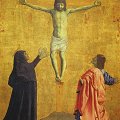 Piero della Francesca, an Italian artist, one of
the greatest artists of the Early Renaissance. His
painting art is characterized by its serene humanism and its use of
geometric forms, particularly in relation to perspective. He wrote
books on solid geometry and on perspective, and his works reflect
these interests. Francesca's solid, rounded figures are derived from
Masaccio, while from Domenico he absorbed a predilection for delicate
colors and scenes bathed in cool, clear daylight. To these influences
he added an innate sense of order and clarity. He
conceived of the human figure as a volume in space, and the outlines
of his subjects have the grace, abstraction, and precision of
geometric drawings. Almost all of Piero's works are religious in
nature - primarily altarpieces and church frescoes in which he
presents scenes of astonishing beauty, with silent, stately
figures fixed in clear, crystalline space. There are always
large areas of white or near-white in his works, the skies are big,
light and sunny. The monumental quality of his figures, the
perspectival construction of the pictorial space and the spiritual
calm of his compositions led, throughout Italy, to the final
surmounting of the Gothic style and prepared the way for the artistic
achievements of High Renaissance in Italy.
Piero della Francesca, an Italian artist, one of
the greatest artists of the Early Renaissance. His
painting art is characterized by its serene humanism and its use of
geometric forms, particularly in relation to perspective. He wrote
books on solid geometry and on perspective, and his works reflect
these interests. Francesca's solid, rounded figures are derived from
Masaccio, while from Domenico he absorbed a predilection for delicate
colors and scenes bathed in cool, clear daylight. To these influences
he added an innate sense of order and clarity. He
conceived of the human figure as a volume in space, and the outlines
of his subjects have the grace, abstraction, and precision of
geometric drawings. Almost all of Piero's works are religious in
nature - primarily altarpieces and church frescoes in which he
presents scenes of astonishing beauty, with silent, stately
figures fixed in clear, crystalline space. There are always
large areas of white or near-white in his works, the skies are big,
light and sunny. The monumental quality of his figures, the
perspectival construction of the pictorial space and the spiritual
calm of his compositions led, throughout Italy, to the final
surmounting of the Gothic style and prepared the way for the artistic
achievements of High Renaissance in Italy.
- Piero della Francesca Art, $19
 (95 pictures)
(95 pictures)
- Piero della Francesca. Evaluation of art.
- Piero della Francesca. Life and art.
October 15, 2010
Our philosophy
You are the artist
"Without an audience, without the presence of spectators, these works would not fulfill the function for which they came into being. The viewer, then, is the ultimate artist." (Dali, 1959)
We regard you, the viewer, as the ultimate artist because without the viewer, art would not fully fulfill the function for which it was made, just as a book without the reader becomes just words on a page. And so, it is the level of interaction between the art and you that we deem to be one of our highest priorities. Art is subjective; your response to each piece is what matters most.
Whether you are a seasoned art lover or an amateur, we are here to provide knowledge and expertise on the vast works of humanity. With over five years of experience in the business of fine art, we offer our clients an unparalleled service in the art business; one that focuses on keeping the highest level of integrity, as well as providing clients with detailed information on each and every work of art.
We believe that art is a window into the soul and it has long reflected the soul of humanity; through triumphs, revolutions, through war, through the forming of nations, art has never left us, expressing and reflecting ourselves, guiding us, enlightening us, pointing the way. Crystallizing the ages of man in one profound work, and kept, to be experienced by the observer as long as that work exists.
We think it an honor and a gift to begin new art collections or add to those which may already exist. And so we are here to help you in presenting of such art to be experienced and enjoyed for many years to come.
August 2, 2009
Albrecht Durer
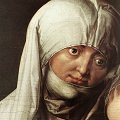 Albrecht Durer, a German painter and printmaker.
Durer is generally regarded as the greatest Northern Renaissance artist. His famous paintings have been the subject of
extensive analysis and interpretation. His watercolours
mark him as one of the first European landscape artists, while his
ambitious woodcuts revolutionized the potential of that medium.
Durer's introduction of classical motifs into Northern art, through
his knowledge of Italian artists and German humanists, have secured
his reputation as one of the most important figures of the Northern
Renaissance. This is reinforced by his theoretical works which involve
principles of mathematics, perspective and ideal proportions. The
quality and wide range of his works and themes, both in terms
of content and formal aspects, are astonishing. Though his paintings
were normally produced as the result of a commission - his two main
areas of focus were portrait painting and the creation of altar pieces
and devotional pictures - Durer enriched them with unusual pictorial
solutions and adapted them to new functions.
After his death, Durer remained one of the most highly regarded of
artists for centuries, representing the process of transition from the
late Middle Ages to the Renaissance in Germany.
Albrecht Durer, a German painter and printmaker.
Durer is generally regarded as the greatest Northern Renaissance artist. His famous paintings have been the subject of
extensive analysis and interpretation. His watercolours
mark him as one of the first European landscape artists, while his
ambitious woodcuts revolutionized the potential of that medium.
Durer's introduction of classical motifs into Northern art, through
his knowledge of Italian artists and German humanists, have secured
his reputation as one of the most important figures of the Northern
Renaissance. This is reinforced by his theoretical works which involve
principles of mathematics, perspective and ideal proportions. The
quality and wide range of his works and themes, both in terms
of content and formal aspects, are astonishing. Though his paintings
were normally produced as the result of a commission - his two main
areas of focus were portrait painting and the creation of altar pieces
and devotional pictures - Durer enriched them with unusual pictorial
solutions and adapted them to new functions.
After his death, Durer remained one of the most highly regarded of
artists for centuries, representing the process of transition from the
late Middle Ages to the Renaissance in Germany.
- Albrecht Durer Art, $25
 (120 pictures)
(120 pictures)
- Albrecht Durer. Altar paintings.
- Albrecht Durer. Portraits.
- Albrecht Durer. Life and work.
July 10, 2009
Kazimir Malevich
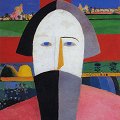 Kazimir Malevich, a Russian painter, pioneer of
geometric abstract art and the originator of the
Suprematism movement. Malevich developed his own
abstract style based strictly on geometric elements, squares and
rectangles. This style became known as Suprematism, referring to
supremacy of "pure artistic feeling". In his first paintings he
presented geometric forms in a limited range of colors, sometimes in
black alone, against a white background. Later he introduced a broader
range of colors as well as triangles, circles, and curved shapes. From
the simplest geometric shapes, Malevich built an entire Suprematist
universe. Kazimir Malevich's art and his Suprematist manifesto are
amongst the most vital artistic developments of the 20th century. He
claimed to have reached the summit of abstract art by denying
objective representation. Infinity, eternity, God, zero of form, the
void, blissful sense of liberating non-objectivity, pure art,
supremacy of pure feeling, spirit of sensation which pervades
everything...
Kazimir Malevich, a Russian painter, pioneer of
geometric abstract art and the originator of the
Suprematism movement. Malevich developed his own
abstract style based strictly on geometric elements, squares and
rectangles. This style became known as Suprematism, referring to
supremacy of "pure artistic feeling". In his first paintings he
presented geometric forms in a limited range of colors, sometimes in
black alone, against a white background. Later he introduced a broader
range of colors as well as triangles, circles, and curved shapes. From
the simplest geometric shapes, Malevich built an entire Suprematist
universe. Kazimir Malevich's art and his Suprematist manifesto are
amongst the most vital artistic developments of the 20th century. He
claimed to have reached the summit of abstract art by denying
objective representation. Infinity, eternity, God, zero of form, the
void, blissful sense of liberating non-objectivity, pure art,
supremacy of pure feeling, spirit of sensation which pervades
everything...
- Kazimir Malevich Art, $25
 (105 pictures)
(105 pictures)
- Kazimir Malevich. Suprematism. Manifesto.
- Kazimir Malevich. Black Square.
June 30, 2008
Henri Matisse
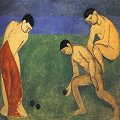 Henri Matisse, French artist, known for his use
of color to convey emotional expression, and his fluid, direct
and original painting style. As a printmaker, but principally as a
painter, Matisse is one of the best-known artists of the 20th century.
His mastery of the expressive language of color and drawing won him
recognition as a leading figure in modern art. Early in his career, he
was the leader of the Fauvist movement, a painting style which
focused on pure colors used in an aggressive and direct manner. Matisse
believed the arrangement of colors was as important as a painting's
subject matter to communicate meaning. He avoided detail, instead
using bright color and strong lines to create a sense of movement.
Although intellectually sophisticated, Matisse always emphasized the
importance of instinct and intuition in the production
of a work of art. He argued that an artist did not have complete
control over color and form; instead, colors, shapes, and lines would
come to dictate to the sensitive artist how they might be employed in
relation to one another. He often emphasized his joy in abandoning
himself to the play of the forces of color and design, and he
explained the rhythmic, but distorted, forms of many of his figures in
terms of the working out of a total artistic harmony.
Henri Matisse, French artist, known for his use
of color to convey emotional expression, and his fluid, direct
and original painting style. As a printmaker, but principally as a
painter, Matisse is one of the best-known artists of the 20th century.
His mastery of the expressive language of color and drawing won him
recognition as a leading figure in modern art. Early in his career, he
was the leader of the Fauvist movement, a painting style which
focused on pure colors used in an aggressive and direct manner. Matisse
believed the arrangement of colors was as important as a painting's
subject matter to communicate meaning. He avoided detail, instead
using bright color and strong lines to create a sense of movement.
Although intellectually sophisticated, Matisse always emphasized the
importance of instinct and intuition in the production
of a work of art. He argued that an artist did not have complete
control over color and form; instead, colors, shapes, and lines would
come to dictate to the sensitive artist how they might be employed in
relation to one another. He often emphasized his joy in abandoning
himself to the play of the forces of color and design, and he
explained the rhythmic, but distorted, forms of many of his figures in
terms of the working out of a total artistic harmony.
- Henri Matisse Art, $29
 (180 pictures)
(180 pictures)
- Henri Matisse. Life and work.
- Henri Matisse. The Music. The Dance.
- Henri Matisse. Simply painting and color.
- Henri Matisse. Paper cutouts.
June 2, 2008
Paul Klee
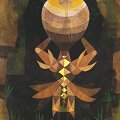 Paul Klee, Swiss German painter, one of the most
original masters of modern art. Klee created images known for their
fantastic dream-like qualities, wit, and imagination. He was
influenced by many different art styles, including
Expressionism, Cubism, and Surrealism. Klee was
also a master draftsman, and many of his works are elaborated line
drawings with subject matter that grew out of fantasy or dream
imagery. Throughout his career, Paul Klee used color in a variety of
unique and diverse means, in a relationship that has progressed and
evolved in a variety of ways. Klee was highly spiritual. Klee
tended to see the world as a model, a kind of illusion run up by the
cosmic clockmaker - God. This helps account for the toy-like character
of his fantasies; if the world had no final reality, it could be
represented in the freest, most schematic way. Klee's career was a
search for the symbols and metaphors. Many of his paintings are
a form of writing: they pullulate with signs, arrows, floating
letters, misplaced directions, and commas; their code for any object
makes no attempt at sensuous description, but instead declares itself
to be a purely mental image, a hieroglyph existing in
emblematic space. Now Klee has become a classic whose pictures are
reproduced in their thousands. They have established themselves firmly
in the collective memory of mankind.
Paul Klee, Swiss German painter, one of the most
original masters of modern art. Klee created images known for their
fantastic dream-like qualities, wit, and imagination. He was
influenced by many different art styles, including
Expressionism, Cubism, and Surrealism. Klee was
also a master draftsman, and many of his works are elaborated line
drawings with subject matter that grew out of fantasy or dream
imagery. Throughout his career, Paul Klee used color in a variety of
unique and diverse means, in a relationship that has progressed and
evolved in a variety of ways. Klee was highly spiritual. Klee
tended to see the world as a model, a kind of illusion run up by the
cosmic clockmaker - God. This helps account for the toy-like character
of his fantasies; if the world had no final reality, it could be
represented in the freest, most schematic way. Klee's career was a
search for the symbols and metaphors. Many of his paintings are
a form of writing: they pullulate with signs, arrows, floating
letters, misplaced directions, and commas; their code for any object
makes no attempt at sensuous description, but instead declares itself
to be a purely mental image, a hieroglyph existing in
emblematic space. Now Klee has become a classic whose pictures are
reproduced in their thousands. They have established themselves firmly
in the collective memory of mankind.
- Paul Klee Art, $25
 (150 pictures)
(150 pictures)
- Paul Klee. Life and work.
- Paul Klee. The freedom of creativity and artistic expression.
May 15, 2008
Marc Chagall
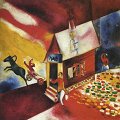 Marc Chagall, Russian-born French painter and
designer, distinguished for his surrealistic inventiveness. He is
recognized as one of the most significant painters and graphic artists
of the 20th century. His work treats subjects in a vein of humor and
fantasy that draws deeply on the resources of the unconscious.
Chagall composed his images based on emotional and poetic
associations, rather than on rules of pictorial logic. Predating
Surrealism, his early works were among the first expressions of
psychic reality in modern art. Chagall's personal and unique
imagery is often suffused with exquisite poetic inspiration.
Chagall's distinctive use of color and form is derived partly from
Russian Expressionism and influenced by French Cubism.
Marc Chagall, Russian-born French painter and
designer, distinguished for his surrealistic inventiveness. He is
recognized as one of the most significant painters and graphic artists
of the 20th century. His work treats subjects in a vein of humor and
fantasy that draws deeply on the resources of the unconscious.
Chagall composed his images based on emotional and poetic
associations, rather than on rules of pictorial logic. Predating
Surrealism, his early works were among the first expressions of
psychic reality in modern art. Chagall's personal and unique
imagery is often suffused with exquisite poetic inspiration.
Chagall's distinctive use of color and form is derived partly from
Russian Expressionism and influenced by French Cubism.
- Marc Chagall Art, $35
 (175 pictures)
(175 pictures)
- Marc Chagall. Art, life, and symbolic expression.
- Marc Chagall. Biography.
- Marc Chagall. About my art.
May 1, 2008
Titian art updated
Titian art pack has been updated with 80+ new, museum quality images:
Titian Art, $29  (175 pictures)
(175 pictures)
March 1, 2008
MoodBook Art Deluxe™ Package
A luxury collector's item
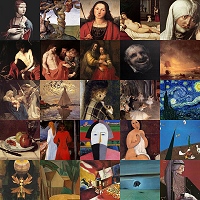 You can buy the entire art collection with all of the packs for only
$229! You save $399. Your computer desktop can look like
You can buy the entire art collection with all of the packs for only
$229! You save $399. Your computer desktop can look like  an art gallery. You
will have thousands of desktop backgrounds, and you will need at least ten years
to view all of the pictures at a moderate pace of one picture a day. Or you can
spend one week viewing one picture a minute. An authentic MoodBook art
collection will be shipped to you as a digital download, packaged in a jewel
digital box, decorated with genuine cover art graphics. A luxury package for
real art lovers, those who appreciate the value of art: 34 art collections,
4700+ art pictures in
3900+ megabytes (MB).
Limited
time offer.
an art gallery. You
will have thousands of desktop backgrounds, and you will need at least ten years
to view all of the pictures at a moderate pace of one picture a day. Or you can
spend one week viewing one picture a minute. An authentic MoodBook art
collection will be shipped to you as a digital download, packaged in a jewel
digital box, decorated with genuine cover art graphics. A luxury package for
real art lovers, those who appreciate the value of art: 34 art collections,
4700+ art pictures in
3900+ megabytes (MB).
Limited
time offer.
January 2, 2008
 There's always
something happening in the MoodBook world! Over the past few weeks,
MoodBook web-site has gone through quite a few changes - some big,
some small, all designed to make the web-site that much better for our
readers. We've implemented major structural improvements across the
entire set of pages. The underlying XML structure of the entire
MoodBook web-site, along with the primary XSLT transformation,
have been significantly revamped and improved. More things now operate
fully automatically. The encyclopedia of art now features new sections
explaining major art movements, such as Renaissance,
Baroque, Romanticism,
Impressionism, Postimpressionism, Modernism, and Postmodernism, and several new art articles. More articles to
follow in the near future. Enjoy the new look and feel of the
encyclopedia and the art pages!
There's always
something happening in the MoodBook world! Over the past few weeks,
MoodBook web-site has gone through quite a few changes - some big,
some small, all designed to make the web-site that much better for our
readers. We've implemented major structural improvements across the
entire set of pages. The underlying XML structure of the entire
MoodBook web-site, along with the primary XSLT transformation,
have been significantly revamped and improved. More things now operate
fully automatically. The encyclopedia of art now features new sections
explaining major art movements, such as Renaissance,
Baroque, Romanticism,
Impressionism, Postimpressionism, Modernism, and Postmodernism, and several new art articles. More articles to
follow in the near future. Enjoy the new look and feel of the
encyclopedia and the art pages!
October 15, 2007
Ivan Aivazovsky
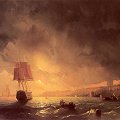 Ivan Aivazovsky, a Russian Armenian painter, most
famous for his seascapes, which constitute more than half of
his paintings. Aivazovskiy had a vivid and emotional understanding of
reality. He always remained a romantic at heart even through his art
could never separate itself from his academic background. The artist's
expressive language was in complete harmony with the techniques that
he used. As a young boy Aivazovskiy had known the sea, had loved it
passionately and had known the secrets of its movements. It was this
memory, together with his imagination, that was responsible for his
best works. Rather than merely "reproduce" the sea, Aivazovskiy tells
us its fables and thus makes a symbolic statement.
Ivan Aivazovsky, a Russian Armenian painter, most
famous for his seascapes, which constitute more than half of
his paintings. Aivazovskiy had a vivid and emotional understanding of
reality. He always remained a romantic at heart even through his art
could never separate itself from his academic background. The artist's
expressive language was in complete harmony with the techniques that
he used. As a young boy Aivazovskiy had known the sea, had loved it
passionately and had known the secrets of its movements. It was this
memory, together with his imagination, that was responsible for his
best works. Rather than merely "reproduce" the sea, Aivazovskiy tells
us its fables and thus makes a symbolic statement.
- Ivan Aivazovsky Art, $29
 (145 pictures)
(145 pictures)
- Ivan Aivazovsky. Life and biography.
June 25, 2007
Caravaggio
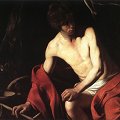 Caravaggio is an Italian painter whose
revolutionary technique of tenebrism, or dramatic, selective
illumination of form out of deep shadow, became a hallmark of Baroque
painting. Scorning the traditional idealized interpretation of
religious subjects, he took his models from the streets and painted
them realistically. His use of models from the lower classes of
society in his early secular works and later religious compositions
appealed to the taste for realism, simplicity, and piety in art.
Equally important is his introduction of dramatic light-and-dark
effects - termed chiaroscuro - into his works. Many Caravaggio's
religious works feature violent struggles, grotesque decapitations,
torture and death. Caravaggio was a "wild" and violent painter
- screams of terror assume a prominent place in many of Caravaggio's
works. The wildness of his personality exploded into his art.
Caravaggio is an Italian painter whose
revolutionary technique of tenebrism, or dramatic, selective
illumination of form out of deep shadow, became a hallmark of Baroque
painting. Scorning the traditional idealized interpretation of
religious subjects, he took his models from the streets and painted
them realistically. His use of models from the lower classes of
society in his early secular works and later religious compositions
appealed to the taste for realism, simplicity, and piety in art.
Equally important is his introduction of dramatic light-and-dark
effects - termed chiaroscuro - into his works. Many Caravaggio's
religious works feature violent struggles, grotesque decapitations,
torture and death. Caravaggio was a "wild" and violent painter
- screams of terror assume a prominent place in many of Caravaggio's
works. The wildness of his personality exploded into his art.
- Caravaggio Art, $25
 (100 pictures)
(100 pictures)
- Caravaggio. Art and life. Biography.
- Caravaggio. Early paintings by Caravaggio.
- Caravaggio. Late paintings by Caravaggio.
May 15, 2007
Francisco de Goya
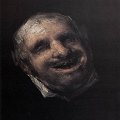 Francisco de Goya is an innovative Spanish Romanticism painter, one of the great Spanish masters. As an
artist, Goya was by temperament far removed from the classicals. In a
few works he approached Classical style, but in the greater part of
his work the Romantic triumphed. Straightforward candor and honesty
are present in all Goya's works. The subversive and subjective element
in his art, as well as his bold handling of paint, provided a model
for the work of later generations of artists. For the bold technique
of his paintings, the haunting satire of his etchings, and his belief
that the artist's vision is more important than tradition, Goya is
often called "the grandfather of modern art". Francisco de Goya became
one of the most influential figures in Spanish art of all time. He was
also extremely important in the development of modern aesthetic
sensibility, a forerunner of Romanticism, both in the content of his
paintings, with their in-depth exploration of reality and references
to the dream world, and in his very original technique.
Francisco de Goya is an innovative Spanish Romanticism painter, one of the great Spanish masters. As an
artist, Goya was by temperament far removed from the classicals. In a
few works he approached Classical style, but in the greater part of
his work the Romantic triumphed. Straightforward candor and honesty
are present in all Goya's works. The subversive and subjective element
in his art, as well as his bold handling of paint, provided a model
for the work of later generations of artists. For the bold technique
of his paintings, the haunting satire of his etchings, and his belief
that the artist's vision is more important than tradition, Goya is
often called "the grandfather of modern art". Francisco de Goya became
one of the most influential figures in Spanish art of all time. He was
also extremely important in the development of modern aesthetic
sensibility, a forerunner of Romanticism, both in the content of his
paintings, with their in-depth exploration of reality and references
to the dream world, and in his very original technique.
- Francisco de Goya Art, $25
 (115 pictures)
(115 pictures)
- Francisco de Goya. Life and biography.
- Francisco de Goya. Art of Goya.
- Francisco de Goya. Early paintings by Goya.
- Francisco de Goya. Intermediate paintings by Goya.
- Francisco de Goya. Late paintings by Goya.
May 1, 2007
Raphael
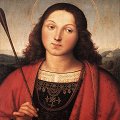 Raphael or Raffaello Sanzio is an Italian High
Renaissance painter and architect of the Florentine
school, celebrated for the perfection and grace of his
art, his mastery of dynamic composition and movement. Raphael, like
Michelangelo and Da Vinci, is one of the most famous artists of Italy's
High Renaissance and one of the greatest influences in the history of
Western art. Raphael is best known for his Madonnas and for his large
figure compositions in the Vatican in Rome. By his artistic means
Raphael has achieved constant movement throughout his
paintings, without letting it become restless or unbalanced. Raphael
was seen to have accomplished what the older generation had striven so
hard to achieve: the perfect and harmonious composition of freely
moving figures.
Raphael or Raffaello Sanzio is an Italian High
Renaissance painter and architect of the Florentine
school, celebrated for the perfection and grace of his
art, his mastery of dynamic composition and movement. Raphael, like
Michelangelo and Da Vinci, is one of the most famous artists of Italy's
High Renaissance and one of the greatest influences in the history of
Western art. Raphael is best known for his Madonnas and for his large
figure compositions in the Vatican in Rome. By his artistic means
Raphael has achieved constant movement throughout his
paintings, without letting it become restless or unbalanced. Raphael
was seen to have accomplished what the older generation had striven so
hard to achieve: the perfect and harmonious composition of freely
moving figures.
- Raphael Art, $25
 (125 pictures)
(125 pictures)
- Raphael. Art, life and biography.
- Raphael. Frescoes in rooms of Vatican.
- Raphael. Religious paintings.
- Raphael. Madonnas.
- Raphael. Portraits.
April 5, 2007
Peter Paul Rubens
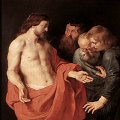 The Flemish and European Baroque painter Peter Paul Rubens was the most renowned northern European
artist of his day, and is now widely recognized as one of the foremost
painters in Western art history. He was the proponent of the Baroque
style which emphasized movement, color, and
sensuality. By completing the fusion of the realistic tradition
of Flemish painting with the imaginative freedom and classical themes
of Italian Renaissance painting, he fundamentally
revitalized and redirected northern European painting. Rubens was one
of the most methodically assimilative and most prodigiously productive
of Western artists. His abundant energy fired him to study and emulate
the masters both of antiquity and of the 16th century in Rome, Venice,
and Parma. His warmth of nature made him responsive to the artistic
revolutions being worked by living artists, and robust powers of
comprehension nourished his limitless resource in invention. He was
able to infuse his own astounding vitality equally into religious and
mythological paintings, portraits, and landscapes. He organized his
complex compositions in vivid, dynamic designs in which limitations of
form and contour are discounted in favour of a constant flow of
movement.
The Flemish and European Baroque painter Peter Paul Rubens was the most renowned northern European
artist of his day, and is now widely recognized as one of the foremost
painters in Western art history. He was the proponent of the Baroque
style which emphasized movement, color, and
sensuality. By completing the fusion of the realistic tradition
of Flemish painting with the imaginative freedom and classical themes
of Italian Renaissance painting, he fundamentally
revitalized and redirected northern European painting. Rubens was one
of the most methodically assimilative and most prodigiously productive
of Western artists. His abundant energy fired him to study and emulate
the masters both of antiquity and of the 16th century in Rome, Venice,
and Parma. His warmth of nature made him responsive to the artistic
revolutions being worked by living artists, and robust powers of
comprehension nourished his limitless resource in invention. He was
able to infuse his own astounding vitality equally into religious and
mythological paintings, portraits, and landscapes. He organized his
complex compositions in vivid, dynamic designs in which limitations of
form and contour are discounted in favour of a constant flow of
movement.
- Peter Paul Rubens Art, $29
 (200 pictures)
(200 pictures)
- Peter Paul Rubens. Art and life. Biography.
- Peter Paul Rubens. Early mythological paintings.
- Peter Paul Rubens. Late mythological paintings.
- Peter Paul Rubens. Early religious paintings.
- Peter Paul Rubens. Late religious paintings.
- Peter Paul Rubens. Portraits.
- Peter Paul Rubens. Landscapes.
February 1, 2007
Michelangelo
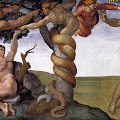 Michelangelo was considered the greatest living
artist in his lifetime, and ever since then he has been held to be one
of the greatest artists of all times. A number of his works in
painting, sculpture, and architecture rank among the most famous in
existence. Michelangelo is one of the greatest artists of all time, a
man whose name has become synonymous with the word "masterpiece". As
an artist he was unmatched, the creator of works of sublime beauty
that express the full breadth of the human condition. Giorgio Vasari
proposed that Michelangelo was the pinnacle of all artistic
achievement since the beginning of the Renaissance, a viewpoint that
continued to be influential in art history for centuries. In his
lifetime he was also often called Il Divino (the divine one),
an appropriate name given his intense spirituality. One of the
qualities most admired by his contemporaries was his sense of
awe-inspiring grandeur, and it was the attempts of subsequent artists
to imitate Michelangelo's impassioned and highly personal style that
resulted in the next major movement in Western art after the High
Renaissance, Mannerism.
Michelangelo was considered the greatest living
artist in his lifetime, and ever since then he has been held to be one
of the greatest artists of all times. A number of his works in
painting, sculpture, and architecture rank among the most famous in
existence. Michelangelo is one of the greatest artists of all time, a
man whose name has become synonymous with the word "masterpiece". As
an artist he was unmatched, the creator of works of sublime beauty
that express the full breadth of the human condition. Giorgio Vasari
proposed that Michelangelo was the pinnacle of all artistic
achievement since the beginning of the Renaissance, a viewpoint that
continued to be influential in art history for centuries. In his
lifetime he was also often called Il Divino (the divine one),
an appropriate name given his intense spirituality. One of the
qualities most admired by his contemporaries was his sense of
awe-inspiring grandeur, and it was the attempts of subsequent artists
to imitate Michelangelo's impassioned and highly personal style that
resulted in the next major movement in Western art after the High
Renaissance, Mannerism.
- Michelangelo Art, $29
 (180 pictures)
(180 pictures)
- Michelangelo. Art, life and biography.
- Michelangelo. Michelangelo's David.
- Michelangelo. Michelangelo's Pieta.
- Michelangelo. Sistine Chapel. High Renaissance Masterpiece.
- Michelangelo. Sistine Chapel. Book of Genesis.
- Michelangelo. Sistine Chapel. The Ignudi.
- Michelangelo. Sistine Chapel. Seven Prophets.
- Michelangelo. Sistine Chapel. Five Sibyls.
- Michelangelo. Sistine Chapel. Lunettes.
- Michelangelo. Sistine Chapel. Pendentives.
- Michelangelo. Sistine Chapel. The Ancestors of Christ.
- Michelangelo. Sistine Chapel. The Last Judgement.
Michelangelo's Sistine Chapel
Michelangelo's greatest glory, the Sistine Chapel, was started in 1508, and completed in 1512. The Sistine Chapel is considered to be the greatest artistic creation in the history of mankind. Michelangelo could possibly be the greatest artist who has ever lived. His paintings in Sistine Chapel, the triumph of the Renaissance humanist ideal, have changed the meaning of art forever.
January 15, 2007
The music catalog is now 250+ GB in size:
- 250+ gigabytes (GB) of music.
- Total play time: 56+ days round the clock.
- 310+ artists, 1300+ albums, 15500+ songs, average bitrate: 380 Kbps.
It now includes FLAC lossless audio files for hi-end music listening, and a lot of biographies and pictures of artists and groups. Enjoy the updated catalog!
January 1, 2007
"Life shakes the hand of death at the moment of conception..."
Edvard Munch
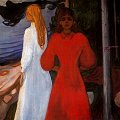 Edvard Munch is a Norwegian
Symbolist/Expressionism painter, whose intense, evocative treatment of
psychological and emotional themes was a major influence on the
development of Expressionism in the early 20th century. Munch is
acclaimed to be the greatest artist of Norway and a father of
Expressionism. Munch's art is now considered a significant force in
modern art. His art is simple, direct, and vigorous in style, yet
powerful in essence and in subject matter. Munch's art works penetrate
beyond external appearances to the inner conditions of the subjects he
painted. Munch's subject matter is symbolist in content, depicting a
state of mind rather than an external reality. The purpose of
Expressionism and Symbolism is to show emotions that the artist feels
in hopes that the viewer will be stirred and feel them as well. The
artist is not concerned with reality as it appears but with its inner
nature and with the emotions aroused by the subject. To achieve these
ends, the subject is frequently exaggerated, distorted, or otherwise
altered in order to stress the emotional experience in its most
intense and concentrated form. Interested in portraying not a random
slice of reality, but situations with emotional content and expressive
energy, Munch carefully calculated his compositions to create a tense
atmosphere.
Edvard Munch is a Norwegian
Symbolist/Expressionism painter, whose intense, evocative treatment of
psychological and emotional themes was a major influence on the
development of Expressionism in the early 20th century. Munch is
acclaimed to be the greatest artist of Norway and a father of
Expressionism. Munch's art is now considered a significant force in
modern art. His art is simple, direct, and vigorous in style, yet
powerful in essence and in subject matter. Munch's art works penetrate
beyond external appearances to the inner conditions of the subjects he
painted. Munch's subject matter is symbolist in content, depicting a
state of mind rather than an external reality. The purpose of
Expressionism and Symbolism is to show emotions that the artist feels
in hopes that the viewer will be stirred and feel them as well. The
artist is not concerned with reality as it appears but with its inner
nature and with the emotions aroused by the subject. To achieve these
ends, the subject is frequently exaggerated, distorted, or otherwise
altered in order to stress the emotional experience in its most
intense and concentrated form. Interested in portraying not a random
slice of reality, but situations with emotional content and expressive
energy, Munch carefully calculated his compositions to create a tense
atmosphere.
- Edvard Munch Art, $19
 (75 pictures)
(75 pictures)
- Edvard Munch. Art, life, and world of symbolic expression.
- Edvard Munch. Art, paintings, and works.
- Edvard Munch. The Scream.
November 15, 2006
175 high-quality paintings by William Bouguereau
"One has to seek beauty and truth, Sir! As I always say to my pupils, you have to work to the finish. There's only one kind of painting. It is the painting that presents the eye with perfection, the kind of beautiful and impeccable enamel you find in Veronese and Titian..."
William Bouguereau
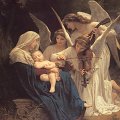 William Bouguereau, a French academic painter. His
polished, refined technique and his sophisticated style represented
the height of achievement in the French academic art tradition. His
work was characterized by a highly finished, technically impeccable
realism and a sentimental interpretation of his subject matter.
Bouguereau paintings look professional, very skilful, and almost real.
He masterfully brought together the elements of exquisite drawing,
incredible coloration and perspective, and brilliant modeling and
compositions. There can be little doubt that Bouguereau was one of the
most talented painters of his time. Bouguereau received many honours
in the 1860s and '70s as his career progressed; he exhibited regularly
at the Salon for several decades and became for a time the most famous
French painter of his day. As a proponent of official orthodoxy in
painting, he played a major role in the exclusion of the works of the
Impressionists and other experimental painters from the Salon. He
exerted a wide influence, not only in France but in other countries,
particularly the United States.
William Bouguereau, a French academic painter. His
polished, refined technique and his sophisticated style represented
the height of achievement in the French academic art tradition. His
work was characterized by a highly finished, technically impeccable
realism and a sentimental interpretation of his subject matter.
Bouguereau paintings look professional, very skilful, and almost real.
He masterfully brought together the elements of exquisite drawing,
incredible coloration and perspective, and brilliant modeling and
compositions. There can be little doubt that Bouguereau was one of the
most talented painters of his time. Bouguereau received many honours
in the 1860s and '70s as his career progressed; he exhibited regularly
at the Salon for several decades and became for a time the most famous
French painter of his day. As a proponent of official orthodoxy in
painting, he played a major role in the exclusion of the works of the
Impressionists and other experimental painters from the Salon. He
exerted a wide influence, not only in France but in other countries,
particularly the United States.
- William Bouguereau Art, $25
 (175 pictures)
(175 pictures)
- William Bouguereau. Art and life. Biography.
October 2, 2006
Rembrandt van Rijn
 Rembrandt van Rijn is generally considered one of
the greatest painters in European art history and the most important
painter in Dutch history. Rembrandt is known as a painter of light and
shade and as an artist who favoured an uncompromising realism.
Rembrandt possessed an exceptional ability to render people in their
various moods and dramatic guises. No artist ever combined more
delicate skill with more energy and power. In all, Rembrandt produced
over 600 paintings, 300 etchings, and 2,000 drawings. He was a
prolific painter of self-portraits, producing almost a hundred of them
throughout his long career. Together they give a remarkably clear
picture of the man, his appearance, and - more importantly - his
deeper being, as revealed by his face. His immediate family, his wife
Saskia, his son Titus, and his common-law wife Hendrickje, often
figured prominently in his paintings. The core of Rembrandt's creative
work, however, consists of biblical and - to a lesser extent -
historical, mythological, and allegorical paintings.
Rembrandt van Rijn is generally considered one of
the greatest painters in European art history and the most important
painter in Dutch history. Rembrandt is known as a painter of light and
shade and as an artist who favoured an uncompromising realism.
Rembrandt possessed an exceptional ability to render people in their
various moods and dramatic guises. No artist ever combined more
delicate skill with more energy and power. In all, Rembrandt produced
over 600 paintings, 300 etchings, and 2,000 drawings. He was a
prolific painter of self-portraits, producing almost a hundred of them
throughout his long career. Together they give a remarkably clear
picture of the man, his appearance, and - more importantly - his
deeper being, as revealed by his face. His immediate family, his wife
Saskia, his son Titus, and his common-law wife Hendrickje, often
figured prominently in his paintings. The core of Rembrandt's creative
work, however, consists of biblical and - to a lesser extent -
historical, mythological, and allegorical paintings.
- Rembrandt van Rijn Art, $25
 (160 pictures)
(160 pictures)
- Rembrandt van Rijn. Art and life. Biography.
- Rembrandt van Rijn. Self-portraits.
- Rembrandt van Rijn. Greatest works.
September 6, 2006
A notable addition to our site is a new page that features a selection of free, ready-made wallpaper images available for free download! It is designed for those of you who want to first become accustomed to the way MoodBook desktop looks and feels prior to actually installing MoodBook on your computer. This is a nice demonstration of the original MoodBook look and feel:
There are a lot of famous artists featured there. All images are hand-picked to create the most definitive collection. Just download and install wallpapers on your desktop as a desktop background. That's it. Make your desktop artsy! Enjoy this free collection!
June 20, 2006
Titian
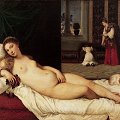 Tiziano Vecellio, better known as Titian, the
leader of the 16th-century Venetian school of the Italian High/Late
Renaissance, and the greatest Venetian artist of the
16th century, the shaper of the Venetian coloristic and painterly
tradition. Titian contributed to all of the major areas of Renaissance
art, painting altarpieces, portraits, mythologies, and pastoral
landscapes. He is one of the key figures in the history of Western
art. His work, which permanently affected the course of European
painting, provided an alternative, of equal power and attractiveness,
to the linear and sculptural Florentine tradition championed by
Michelangelo and Raphael; this
alternative, eagerly taken up by Rubens, Diego Velazquez, Rembrandt, Eugene Delacroix, and the Impressionists, is
still vital today. In its own right Titian's work often attains the
very highest reach of human achievement in the visual arts.
Tiziano Vecellio, better known as Titian, the
leader of the 16th-century Venetian school of the Italian High/Late
Renaissance, and the greatest Venetian artist of the
16th century, the shaper of the Venetian coloristic and painterly
tradition. Titian contributed to all of the major areas of Renaissance
art, painting altarpieces, portraits, mythologies, and pastoral
landscapes. He is one of the key figures in the history of Western
art. His work, which permanently affected the course of European
painting, provided an alternative, of equal power and attractiveness,
to the linear and sculptural Florentine tradition championed by
Michelangelo and Raphael; this
alternative, eagerly taken up by Rubens, Diego Velazquez, Rembrandt, Eugene Delacroix, and the Impressionists, is
still vital today. In its own right Titian's work often attains the
very highest reach of human achievement in the visual arts.
- Titian Art, $29
 (175 pictures)
(175 pictures)
- Titian. Art and life.
- Titian. Early art works by Titian.
- Titian. Late art works by Titian.
June 1, 2006
We are proud to announce a new major section on our web-site:
This new section currently provides a brief explanation of history of arts starting from Renaissance period. The overview will improve over time with new content additions. This section will serve as a central index and common repository for all art articles on the MoodBook site and will be ever expanding with new articles over time, to create a complete story of art from the beginnings to our days.
Enjoy!
April 12, 2006
Edgar Degas
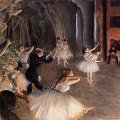 Edgar Degas, French painter and sculptor, known
especially for his paintings of ballet dancers. Other subjects that he
frequently returned to include horse races, women bathing, and
portraits of friends and relatives. Degas combined a modern focus on
the creation of unusual compositions and the rendering of movement
with a traditional emphasis on skillful drawing. Degas is usually
classed with the Impressionism, but he stood somewhat
apart from the other artists in this group. He did not share the
Impressionists' fascination with natural light and its effects, and he
disliked painting directly from nature, preferring instead to work in
the studio. Moreover, Degas had little interest in landscape - the
primary subject matter of the Impressionists - and concentrated
instead on the human figure. Also unlike the Impressionists, Degas was
interested in drawing and emphasized line in his work.
Edgar Degas, French painter and sculptor, known
especially for his paintings of ballet dancers. Other subjects that he
frequently returned to include horse races, women bathing, and
portraits of friends and relatives. Degas combined a modern focus on
the creation of unusual compositions and the rendering of movement
with a traditional emphasis on skillful drawing. Degas is usually
classed with the Impressionism, but he stood somewhat
apart from the other artists in this group. He did not share the
Impressionists' fascination with natural light and its effects, and he
disliked painting directly from nature, preferring instead to work in
the studio. Moreover, Degas had little interest in landscape - the
primary subject matter of the Impressionists - and concentrated
instead on the human figure. Also unlike the Impressionists, Degas was
interested in drawing and emphasized line in his work.
- Edgar Degas Art, $25
 (170 pictures)
(170 pictures)
- Edgar Degas. Life and work.
March 20, 2006
Fantasy Art
 Probably the best collection of fantasy and surreal art
images by classic artists of '70s, '80s, and '90s. Psychedelic,
visionary and fantasy art of both fantasy and surreal worlds.
Fantasy art is an art of depictions of ancient myths and
legends, as well as depictions of modern day fantasy in the form of
divine interventions and other magical or supernatural forces. These
are very common elements, and help distinguish fantasy art from other
forms. Fantastic fantasy art worlds are filled with creatures,
castles, dungeons, dragons, heroes and beautiful maidens, fairies,
gods and monsters, all in a style inspired by classic illustrators.
Probably the best collection of fantasy and surreal art
images by classic artists of '70s, '80s, and '90s. Psychedelic,
visionary and fantasy art of both fantasy and surreal worlds.
Fantasy art is an art of depictions of ancient myths and
legends, as well as depictions of modern day fantasy in the form of
divine interventions and other magical or supernatural forces. These
are very common elements, and help distinguish fantasy art from other
forms. Fantastic fantasy art worlds are filled with creatures,
castles, dungeons, dragons, heroes and beautiful maidens, fairies,
gods and monsters, all in a style inspired by classic illustrators.
- Fantasy Art, $29
 (195 pictures)
(195 pictures)
February 6, 2006
Sci-Fi Art
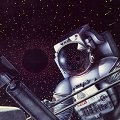 Probably the best collection of sci-fi art images by classic artists
of '70s, '80s, and '90s. Sci-fi stands for science
fiction. Dreams of galaxies, planets and unknown dimensions.
Cosmic scenes and planetary landscapes, futuristic realms, spaceships
and alien buildings.
Probably the best collection of sci-fi art images by classic artists
of '70s, '80s, and '90s. Sci-fi stands for science
fiction. Dreams of galaxies, planets and unknown dimensions.
Cosmic scenes and planetary landscapes, futuristic realms, spaceships
and alien buildings.
- Sci-Fi Art, $25
 (125 pictures)
(125 pictures)
"I've seen things you people wouldn't believe. Attack ships on fire off the shoulder of Orion. I watched C-beams glitter in the dark near the Tannhauser gate. All those moments will be lost in time, like tears in the rain..."
January 6, 2006
MoodBook™ 2.5
The latest and greatest MoodBook™ 2.5 hits the streets!
- New artistic effects for the background.
- Ability to display pictures in full screen mode.
- About three times faster now.
- Ability to export your favorite pictures to JPEG files.
- Minor tweaks, fixes, and more...
MoodBook 2.5 2.5 MB
Additionally, FAQ section is now available on the web-site.
November 1, 2005
Pierre-Auguste Renoir
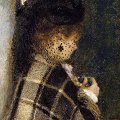 Pierre-Auguste Renoir, a French painter originally
associated with the Impressionism movement. Renoir's
paintings show vibrant light and color, and harmony of lines. Unlike
many Impressionists who focused on landscapes, he painted not only
landscapes, but people in intimate and candid compositions - sometimes
applying paint with a palette knife rather than a brush. Renoir was
one of the great worshippers of the female form, and he said "I never
think I have finished a nude until I think I could pinch it".
Recognized by critics as one of the greatest and most independent
painters of his period, Renoir is noted for the intimate charm of his
wide variety of subjects. Pierre-Auguste Renoir was undoubtedly one of
the most prolific artists ever with about 6000 paintings
completed during the 60 years he was active as an artist. Two of
Renoir's paintings have sold for more than $70 million.
Pierre-Auguste Renoir, a French painter originally
associated with the Impressionism movement. Renoir's
paintings show vibrant light and color, and harmony of lines. Unlike
many Impressionists who focused on landscapes, he painted not only
landscapes, but people in intimate and candid compositions - sometimes
applying paint with a palette knife rather than a brush. Renoir was
one of the great worshippers of the female form, and he said "I never
think I have finished a nude until I think I could pinch it".
Recognized by critics as one of the greatest and most independent
painters of his period, Renoir is noted for the intimate charm of his
wide variety of subjects. Pierre-Auguste Renoir was undoubtedly one of
the most prolific artists ever with about 6000 paintings
completed during the 60 years he was active as an artist. Two of
Renoir's paintings have sold for more than $70 million.
- Pierre-Auguste Renoir Art, $39
 (300 pictures)
(300 pictures)
- Pierre-Auguste Renoir. Life and work.
October 12, 2005
Leonardo da Vinci
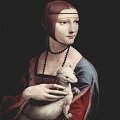 Leonardo da Vinci, Italian High Renaissance painter, sculptor, architect, engineer, scientist and
inventor. Leonardo da Vinci was an amazing painter. His paintings
contained incredible detail, which made them seem almost real. This
detail included things like various shadow effects and textures which
gave the works lifelike appearances. Although Leonardo produced a
relatively small number of paintings, many of which remained
unfinished, he was nevertheless an extraordinarily innovative
and influential artist. As a scientist Leonardo towered above all his
contemporaries - Leonardo actually anticipated many discoveries of
modern times. In anatomy he studied the circulation of the blood and
the action of the eye. He made discoveries in meteorology and geology,
learned the effect of the moon on the tides, foreshadowed modern
conceptions of continent formation, and surmised the nature of fossil
shells. He was among the originators of the science of hydraulics. He
invented a large number of ingenious machines, many potentially
useful.
Leonardo da Vinci, Italian High Renaissance painter, sculptor, architect, engineer, scientist and
inventor. Leonardo da Vinci was an amazing painter. His paintings
contained incredible detail, which made them seem almost real. This
detail included things like various shadow effects and textures which
gave the works lifelike appearances. Although Leonardo produced a
relatively small number of paintings, many of which remained
unfinished, he was nevertheless an extraordinarily innovative
and influential artist. As a scientist Leonardo towered above all his
contemporaries - Leonardo actually anticipated many discoveries of
modern times. In anatomy he studied the circulation of the blood and
the action of the eye. He made discoveries in meteorology and geology,
learned the effect of the moon on the tides, foreshadowed modern
conceptions of continent formation, and surmised the nature of fossil
shells. He was among the originators of the science of hydraulics. He
invented a large number of ingenious machines, many potentially
useful.
- Leonardo da Vinci Art, $25
 (80 pictures)
(80 pictures)
- Leonardo da Vinci. Life and biography.
- Leonardo da Vinci. Evaluation of art.
The Mona Lisa by Leonardo da Vinci is often described as the most famous piece in art history. Guinness Book of Records lists the Mona Lisa as the highest insurance value for a painting in history.
October 1, 2005
The music catalog has been updated:
- 84+ gigabytes (GB) of music.
- Total play time: 29+ days round the clock.
- 160+ artists, 600+ albums, 8400+ songs, average bitrate: 260 Kbps.
Major structural improvements across all XSL source files which control automatic XML to HTML conversion for this online music catalog. Now this conversion is really fully automatic. This also resulted in some structural changes to the front end look and feel of the index page. Enjoy the new look and feel of the music pages!
August 2, 2005
"Everyone discusses my artwork and pretends to understand, when it is simply necessary to love... You must know I'm entirely absorbed in my work. These landscapes of water and reflections have become an obsession. It's quite beyond my powers at my age, and yet I want to succeed at expressing what I feel..."
Claude Monet
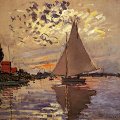 Claude Monet, French painter, is generally
considered to be the most outstanding figure among Impressionists. The
term Impressionism derives from his picture Impression:
Sunrise. Monet was using the short brush strokes, which often
looked rather like spots of paint, not lines. For this reason his
paintings seemed to some people messy and unfinished. Often, when you
looked at his painting from a short distance you couldn't see what it
was, but if you stepped away you could see a beautiful scene. This was
a completely new way of painting that became the mark of Impressionism. Monet was enormously prolific and many major
galleries have examples of his work. Through his life Monet painted
about 2500 paintings. For many years Monet's and other
Impressionists' paintings were not understood and rejected by people
of that time. But finally by the end of century the new way of
painting became liked and popular. Impressionism enriched art, and
taught people to be open and ready to welcome and enjoy the new
styles. Claude Monet, as the leader of Impressionists, made this
success possible in the big part. Without Claude Monet art would
probably never become so interesting, and full of light, and beauty.
Claude Monet, French painter, is generally
considered to be the most outstanding figure among Impressionists. The
term Impressionism derives from his picture Impression:
Sunrise. Monet was using the short brush strokes, which often
looked rather like spots of paint, not lines. For this reason his
paintings seemed to some people messy and unfinished. Often, when you
looked at his painting from a short distance you couldn't see what it
was, but if you stepped away you could see a beautiful scene. This was
a completely new way of painting that became the mark of Impressionism. Monet was enormously prolific and many major
galleries have examples of his work. Through his life Monet painted
about 2500 paintings. For many years Monet's and other
Impressionists' paintings were not understood and rejected by people
of that time. But finally by the end of century the new way of
painting became liked and popular. Impressionism enriched art, and
taught people to be open and ready to welcome and enjoy the new
styles. Claude Monet, as the leader of Impressionists, made this
success possible in the big part. Without Claude Monet art would
probably never become so interesting, and full of light, and beauty.
- Claude Monet Art, $35
 (250 pictures)
(250 pictures)
- Claude Monet. Life and work.
- Claude Monet. Starting the Impressionism.
- Claude Monet. Colors in Claude Monet's paintings.
- Claude Monet. Best paintings.
July 5, 2005
New articles on the site. Art of Dali is in the spotlight, explored, revealed, and analyzed. A formal analysis of a work of art is an analysis of the form that the artist has produced. Line, shape, color, texture, mass and composition are the elements of the form of the artwork. These elements make up the expression, content and meaning of the work. Think about it like this: letters make up words, words make sentences and sentences make up paragraphs, which convey meaning to the reader. Art elements are like the letters and words. When they are used in a work of art, they translate into meaning and content for the viewer. The elements are the clues you use to begin to decode the information in the work of art. The analysis conveys how the artist uses the elements to convey meaning. Knowing how to write a formal analysis of a work of art is a fundamental skill learned in an art appreciation-level class.
June 15, 2005
To better represent the real value behind art, and to help us cover the associated production costs, we've decided to change prices to most of the art packs available on this web-site. Even with the current rates, MoodBook art is still the best value for money invested, and is still very affordable, considering the popularity of artists, the breadth of selections, and the quality and authenticity of works. Art is priceless, but thanks to MoodBook, it can actually be affordable!
April 5, 2005
World of Flowers
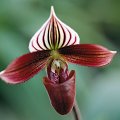 Discover the striking beauty of flowers with this photo
collection. Flowers from all over the world. Wild nature, impressive
colors, and a joy forever. Many plants produce highly visible flowers
that have a distinctive size, color, or fragrance. Almost everyone is
familiar with beautiful flowers such as the blossoms of roses,
orchids, and tulips. Flowering plants are more widespread than any
other group of plants. They bloom on every continent, from the bogs
and marshes of the Arctic tundra to the barren soils of Antarctica.
Deserts, grasslands, rainforests, and other biomes display distinctive
flower species. Flowers are one of the most meaningful gifts a person
can give or receive. Over time, the act of giving flowers developed
into its own unique language, with every flower assigned its own
special meaning. Flowers have been a symbol of love since ancient
times. Consider a new, hi-tech, ultra-modern way of expressing your
feelings!
Discover the striking beauty of flowers with this photo
collection. Flowers from all over the world. Wild nature, impressive
colors, and a joy forever. Many plants produce highly visible flowers
that have a distinctive size, color, or fragrance. Almost everyone is
familiar with beautiful flowers such as the blossoms of roses,
orchids, and tulips. Flowering plants are more widespread than any
other group of plants. They bloom on every continent, from the bogs
and marshes of the Arctic tundra to the barren soils of Antarctica.
Deserts, grasslands, rainforests, and other biomes display distinctive
flower species. Flowers are one of the most meaningful gifts a person
can give or receive. Over time, the act of giving flowers developed
into its own unique language, with every flower assigned its own
special meaning. Flowers have been a symbol of love since ancient
times. Consider a new, hi-tech, ultra-modern way of expressing your
feelings!
- World of Flowers, $15
 (90 pictures)
(90 pictures)
February 5, 2005
275 high-quality paintings by Salvador Dali
"Don't bother about being modern. Unfortunately it is the one thing that, whatever you do, you cannot avoid... The world will admire me. Perhaps I'll be despised and misunderstood, but I'll be a great genius, I'm certain of it..."
Salvador Dali
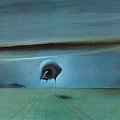 Salvador Dali, one of the greatest Spanish
painters of all time, and one of the most important figures in the
history of Modernism. Both Dali's extraordinary
talent and odd personality helped him to rise above the rest of the
Surrealists of the 20th century. His artwork and influences can be
seen almost everywhere around the world. His explicit and
controversial Surrealist paintings are some of the most famous, and
infamous, paintings of the 1900's, and his rebellious and independent
attitude towards art and politics set him aside from other painters,
leaving a mark on Surrealist painting forever. Dali expressed
surrealism in everything he said and did. He was not just
unconventional and dramatic; he was fantastic, shocking, and
outrageous. Salvador Dali remains one of the great artistic innovators
of all time. Like Picasso,
Matisse, Miro and
Chagall, his place at the pinnacle of modern
art history is assured.
Salvador Dali, one of the greatest Spanish
painters of all time, and one of the most important figures in the
history of Modernism. Both Dali's extraordinary
talent and odd personality helped him to rise above the rest of the
Surrealists of the 20th century. His artwork and influences can be
seen almost everywhere around the world. His explicit and
controversial Surrealist paintings are some of the most famous, and
infamous, paintings of the 1900's, and his rebellious and independent
attitude towards art and politics set him aside from other painters,
leaving a mark on Surrealist painting forever. Dali expressed
surrealism in everything he said and did. He was not just
unconventional and dramatic; he was fantastic, shocking, and
outrageous. Salvador Dali remains one of the great artistic innovators
of all time. Like Picasso,
Matisse, Miro and
Chagall, his place at the pinnacle of modern
art history is assured.
- Salvador Dali Art, $35
 (275 pictures)
(275 pictures)
- Salvador Dali. Art, life, and world of surreal.
- Salvador Dali. Early years. Art, paintings, and works.
- Salvador Dali. Surreal years. Art, paintings, and works.
- Salvador Dali. Classical years. Art, paintings, and works.
The internationally renowned Dali expert and biographer, Robert Descharnes, wrote in 1995: "Those who are enthralled by artistic creation: those who possess the poet's capacity for wonder and dread; those who are inhabited by dreams; those who know that love and war were fundamental to human existence - such people will forget the few miasmas that are already being dissipated by the winds of time. They will encounter the landmarks that enable one to discover and comprehend the battle which Salvador Dali waged, all obstacles notwithstanding, in order to sow the seeds of the graphic art of tomorrow."
January 1, 2005
 The underlying
XML structure of the entire MoodBook web-site, along with the
primary XSLT transformation, has been significantly revamped.
More things now operate fully automatically, for example, thumbnail
generation. This resulted in some changes to the front end look and
feel - in particular image previews are now smaller. Additionally, the
Zip compressed copy of the web-site is no longer available, now that
the web-site is rather complex with quite a few files to maintain.
Enjoy the new look and feel of the art pages!
The underlying
XML structure of the entire MoodBook web-site, along with the
primary XSLT transformation, has been significantly revamped.
More things now operate fully automatically, for example, thumbnail
generation. This resulted in some changes to the front end look and
feel - in particular image previews are now smaller. Additionally, the
Zip compressed copy of the web-site is no longer available, now that
the web-site is rather complex with quite a few files to maintain.
Enjoy the new look and feel of the art pages!
December 1, 2004
Paul Gauguin
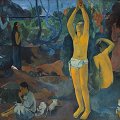 Paul Gauguin, one of the leading French painters
of the Postimpressionism period, whose development of
a conceptual method of representation was a decisive step for
20th-century art. Gauguin's paintings are powerful, while the subject
matter is distinctive, the scale is large, and the compositions are
simplified. Gauguin implied the qualities of expressive color, denial
of perspective, and thick, flat forms. "The further I go, the more I
feel sure that thoughts can be expressed by something quite different
from literature," Gauguin wrote. Gauguin's artistic development of a
conceptual method of representation was important for the history of
art as it moved into the twentieth century. Painters no longer aimed
at depicting the outer world but at rendering their inner dreams by
symbolic allusion and decorative form. Line and color developed their
powers of expression, taking inspiration in global art.
Paul Gauguin, one of the leading French painters
of the Postimpressionism period, whose development of
a conceptual method of representation was a decisive step for
20th-century art. Gauguin's paintings are powerful, while the subject
matter is distinctive, the scale is large, and the compositions are
simplified. Gauguin implied the qualities of expressive color, denial
of perspective, and thick, flat forms. "The further I go, the more I
feel sure that thoughts can be expressed by something quite different
from literature," Gauguin wrote. Gauguin's artistic development of a
conceptual method of representation was important for the history of
art as it moved into the twentieth century. Painters no longer aimed
at depicting the outer world but at rendering their inner dreams by
symbolic allusion and decorative form. Line and color developed their
powers of expression, taking inspiration in global art.
- Paul Gauguin Art, $25
 (125 pictures)
(125 pictures)
- Paul Gauguin. Life and work.
November 1, 2004
Paul Cezanne
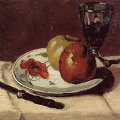 Explore the expression and emotion of color with Paul Cezanne, the Post-Impressionist, who achieved perfection
through a unique treatment of space, mass, and color. The French
painter Paul Cezanne is one of the greatest of the
Post-Impressionists, whose works and ideas were influential in the
aesthetic development of many 20'th century artists and art movements,
especially Cubism. It is the tension between actuality and illusion,
description and abstraction, reality and invention, that makes
Cezanne's most unassuming subjects so profoundly satisfying and
exciting, and which provided a legacy for a revolution of form that
led the way for modern art. By the time of his death in 1906,
Cezanne's art had begun to be shown and seen across Europe, and it
became a fundamental influence on the Fauves, the Cubists, and
virtually all advanced art of the early 20th century.
Explore the expression and emotion of color with Paul Cezanne, the Post-Impressionist, who achieved perfection
through a unique treatment of space, mass, and color. The French
painter Paul Cezanne is one of the greatest of the
Post-Impressionists, whose works and ideas were influential in the
aesthetic development of many 20'th century artists and art movements,
especially Cubism. It is the tension between actuality and illusion,
description and abstraction, reality and invention, that makes
Cezanne's most unassuming subjects so profoundly satisfying and
exciting, and which provided a legacy for a revolution of form that
led the way for modern art. By the time of his death in 1906,
Cezanne's art had begun to be shown and seen across Europe, and it
became a fundamental influence on the Fauves, the Cubists, and
virtually all advanced art of the early 20th century.
- Paul Cezanne Art, $25
 (125 pictures)
(125 pictures)
- Paul Cezanne. Life and work.
- Paul Cezanne. Starting the modern art.
October 17, 2004
The music catalog has been updated:
- 43+ gigabytes (GB) of music.
- Total play time: 15+ days.
New entries include Modern Talking, Dire Straits, Jean Michel Jarre, Yello, Kraftwerk, Space, Zodiac, Dead Can Dance, and updated albums for Enigma and Paul McCartney.
October 12, 2004
With a few minor corrections, MoodBook 2 has gone gold!
MoodBook 2.0 2.5 MB
September 7, 2004
A total of four art packs are now available for download:
-
Pablo Picasso Art, $29
 (175 pictures)
(175 pictures)
-
Vincent van Gogh Art, $25
 (100 pictures)
(100 pictures)
-
Clip Arts Extended Pack, $15
 (75 pictures)
(75 pictures)
- Fine Arts Extended Pack, free (50 pictures)
More packs to follow.
August 20, 2004
 The structure of the site has been
updated largely. The site is now fully XML-based. Each XHTML
page on the site is generated from a corresponding XML source
document. Each art pack is represented with a special XML file and an
index page consolidates all of the available art packs:
The structure of the site has been
updated largely. The site is now fully XML-based. Each XHTML
page on the site is generated from a corresponding XML source
document. Each art pack is represented with a special XML file and an
index page consolidates all of the available art packs:
August 8, 2004
There've been a lot of development work with respect to MoodBook for the recent few months, and we're now ready to publicly present a pre-release version of MoodBook 2. This newest release features numerous improvements along with a number of important innovations:
- MoodBook is now able to draw JPEG images on the desktop.
This prepares MoodBook for a traditional oil-painted fine art. Soon
you'll be able to download the world's best works of painted art, and
place it on your desktop easily. The fine art paintings in JPEG format
are imaged with a surrounded black and dark gray frames to create
natural look and feel of the art exposition, just as in the art
gallery.
- Additionally, MoodBook now comes with a built-in 1.2 MB fine arts basic pack which includes 25 fine art images for your desktop, ranging from Renaissance to Baroque to Impressionism to Modernism, and more. Da Vinci, Sebastiano Ricci, Nicolas Poussin, Van Gogh, Vasily Kandinsky, Picasso, Dali, and more! Unfortunately, this pack has increased the installation package of MoodBook up to 2.5 MB. Fortunately, the art in this pack looks great!
- We have changed the way backgrounds are colored. By
default, they are now less saturated and less luminated, and overall
less contrasting. We tried to match the default settings to as many
monitors as possible. Let us know ()
if you like the new backgrounds and how they can further be improved.
Unfortunately, different monitors may have different gamma settings,
and for some monitors these new settings may look rather dark or dim,
so let us know if you like the new coloring!
- Additionally, the main image from the center is now embossed into the background to create a nice artistic effect. It visibly fills the unused blank areas of the background. Still, we tried to make it as non-intrusive as possible.
Pictures
Colors
Why wait? Download now!
- MoodBook 2.0 2.5 MB
More news to follow in the near future. Stay tuned...
June 1, 2004
Major additions to the music catalog. Complete and nearly complete discographies of The Beatles, A-ha, and Michael Jackson. Pet Shop Boys' collection largely updated and is now of a higher MP3 quality. A lot of new trance albums and compilations. As from now, the primary target format is Lame's MP3 320 Kbps Stereo. The statistics now is as follows:
- 35+ gigabytes (GB) of music.
- Total play time: 13+ days.
April 2, 2004
The music catalog has been updated with a few new albums, and XHTML meta tag descriptions. The latter involved modifying the primary XSLT transformation. Additionally, an XSLT transformation that queries all of the XML music files and creates a single CSV file, has been added. This allows easier exporting of the entire catalog to Microsoft Excel for further analysis and manipulation. For example, we are now able to publish the following information at the front page of the catalog:
- 27+ gigabytes (GB) of music.
- Total play time: 11+ days.
All in a few clicks, including other possible statistical information! For example, if you want information in more detail, here it is: 3007 tracks, 27671884658 bytes, 11 days 16 hours 56 minutes 34 seconds of play time, 212 albums, 51 artists. Average MP3 bitrate is 218 Kbps. The information is actual as of April, 2004. The XSLT transformation to generate the consolidated CSV file is available in the Zip package, along with all the data files and other transformations.
February 15, 2004
Lately we have uploaded a large amount of content to this web-site, namely the XHTML version of our MP3 music catalog. It is now available at:
The catalog features many popular groups and artists, such as Paul McCartney, Pet Shop Boys, Depeche Mode, Madonna, Enigma, and more! It also includes a special section devoted to modern trance music, featuring the brightest trance and house DJ talents from all over the world! The catalog partially includes biographies, pictures, and discographies. A special article covering the technologies we use to create and publish this music catalog online, is also available. It is intended to unveil the power of music cataloging with Argentum MyFiles, a disk cataloger and file organizer, as well as, to give people some basic information on XML, XSLT and XHTML.
January 20, 2004
One more art pack has been added to the Packs section. It's a computer arts extended pack. Extend your art collection with this bonus pack for MoodBook! Bring more pictures to your desktop to excite, inspire and educate! The extended computer arts pack is a 2 MB downloadable package which includes 75 pictures with a look and feel similar to a look and feel of the MoodBook's built-in set of basic computer art. Most pictures look genuinely abstract and stylish.
January 4, 2004
Okay, the MoodBook web-site is finally up. The MoodBook installation package has been uploaded. From then on MoodBook is going to conquer the world. Ready, set, go!
December 10, 2003
MoodBook web-site along with the pre-release of MoodBook is available to a limited number of Argentum Newsletter subscribers.

